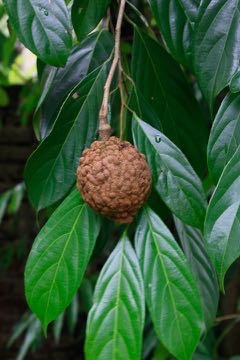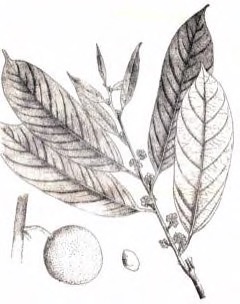 |
|
wikimedia.org |
 |
| http://www.edibleplants.org |
Translate this page:
Summary
Chaulmugra or Hydnocarpus kurzii is a tree growing up to 20-30 m tall and 15 m wide that can be found in East Asia. The leaves are oblong. The fruits are used as a fish poison. Chaulmugra oil obtained from the seed is used in the treatment of leprosy. Bark decoction is drunk as a general tonic to improve health and in the treatment of skin conditions and internal disorders. The roots and seeds are used by Thai traditional doctors for skin diseases.
Physical Characteristics

 Hydnocarpus kurzii is an evergreen Tree growing to 15 m (49ft) by 15 m (49ft) at a medium rate.
Hydnocarpus kurzii is an evergreen Tree growing to 15 m (49ft) by 15 m (49ft) at a medium rate.
See above for USDA hardiness. It is hardy to UK zone 10. The plant is not self-fertile.
Suitable for: light (sandy), medium (loamy) and heavy (clay) soils and prefers well-drained soil. Suitable pH: mildly acid and neutral soils and can grow in very acid soils.
It can grow in semi-shade (light woodland) or no shade. It prefers moist soil.
UK Hardiness Map
US Hardiness Map
Synonyms
Taraktogenos kurzii King
Plant Habitats
Edible Uses
References More on Edible Uses
Medicinal Uses
Plants For A Future can not take any responsibility for any adverse effects from the use of plants. Always seek advice from a professional before using a plant medicinally.
Cancer Leprosy Skin Tonic
The oil extracted from the seeds, known as 'chaulmugra oil', has a long history of use in the treatment of leprosy[310 , 317 ]. When applied externally, and by direct infiltration of the lesions, it has been shown to be effective in decreasing the size of nodules, numb patches, and skin lesions[555 ]. The active principles are unusual cyclopentenic fatty acids including chaulmoogric acid. The precise molecular mycobactericidal mode of action is still unknown[555 ].. The oil contains chaulmoogric and hydnocarpic fatty acids[310 , 317 ]. A decoction of the bark is drunk as a general tonic to improve health and in the treatment of internal disorders and skin diseases[310 , 555 ]. The roots, as well as the seeds, are used by Thai traditional doctors in the treatment of skin diseases[310 ]. An exciting development from this plant is the observation that the oil, when applied to the skin, increases the strength of scar tissue and strengthens the collagen tissue in wounds. Hence some cosmetic and or dermatological application may be possible[555 ]. In addition, the lignans hydnowightin, hydnocarpin, and neohydnocarpin have been isolated in the plant. These have been shown to have cytotoxic potential against various forms of cancer[555 ].
References More on Medicinal Uses
The Bookshop: Edible Plant Books
Our Latest books on Perennial Plants For Food Forests and Permaculture Gardens in paperback or digital formats.

Edible Tropical Plants
Food Forest Plants for Hotter Conditions: 250+ Plants For Tropical Food Forests & Permaculture Gardens.
More

Edible Temperate Plants
Plants for Your Food Forest: 500 Plants for Temperate Food Forests & Permaculture Gardens.
More

More Books
PFAF have eight books available in paperback and digital formats. Browse the shop for more information.
Shop Now
Other Uses
References More on Other Uses
Cultivation details
A plant of the wet tropics, where it can be found at elevations up to 1,800 metres. The plant grows best in areas where annual daytime annual temperatures fall within the range 28 - 34°c, though it is tolerant of 7 - 42°c[418 ]. It is tolerant of temperatures to below 2.5°c[418 ]. It prefers a mean annual rainfall in the range 3,500 - 6,500mm, but can tolerate 2,000 - 8,000mm[418 ]. Succeeds in full sun and light shade[418 ]. Tolerant of a range of soils, preferring a pH in the range 4.5 - 5, but tolerating 4 - 5.5[418 ].
References Carbon Farming Information and Carbon Sequestration Information
Temperature Converter
Type a value in the Celsius field to convert the value to Fahrenheit:
Fahrenheit:
The PFAF Bookshop
Plants For A Future have a number of books available in paperback and digital form. Book titles include Edible Plants, Edible Perennials, Edible Trees,Edible Shrubs, Woodland Gardening, and Temperate Food Forest Plants. Our new book is Food Forest Plants For Hotter Conditions (Tropical and Sub-Tropical).
Shop Now
Plant Propagation
Seed
Other Names
If available other names are mentioned here
Dalmugri, Chaulmugra, Niradi-muttu, Lamtem, Dieng-soh-lap, Balibu, Rowai-thing, chaulmoogra, chaulmoogra oil tree, chaulmoograträd, cholmugra, nirati, tuvaraka.
Native Range
TROPICAL ASIA: India (Assam, Manipur, Tripura, Mizoram), Laos, Myanmar, Vietnam
Weed Potential
Right plant wrong place. We are currently updating this section.
Please note that a plant may be invasive in one area but may not in your area so it's worth checking.
Conservation Status
IUCN Red List of Threatened Plants Status : Status: Data Deficient

Growth: S = slow M = medium F = fast. Soil: L = light (sandy) M = medium H = heavy (clay). pH: A = acid N = neutral B = basic (alkaline). Shade: F = full shade S = semi-shade N = no shade. Moisture: D = dry M = Moist We = wet Wa = water.
Now available:
Food Forest Plants for Mediterranean Conditions
350+ Perennial Plants For Mediterranean and Drier Food Forests and Permaculture Gardens.
[Paperback and eBook]
This is the third in Plants For A Future's series of plant guides for food forests tailored to
specific climate zones. Following volumes on temperate and tropical ecosystems, this book focuses
on species suited to Mediterranean conditions—regions with hot, dry summers and cool, wet winters,
often facing the added challenge of climate change.
Read More
Expert comment
Author
(King) Warb.
Botanical References
1
Links / References
For a list of references used on this page please go here
A special thanks to Ken Fern for some of the information used on this page.
Readers comment
| Add a comment |
|
If you have important information about this plant that may help other users please add a comment or link below. Only comments or links that are felt to be directly relevant to a plant will be included. If you think a comment/link or information contained on this page is inaccurate or misleading we would welcome your feedback at [email protected]. If you have questions about a plant please use the Forum on this website as we do not have the resources to answer questions ourselves.
* Please note: the comments by website users are not necessarily those held by PFAF and may give misleading or inaccurate information.
To leave a comment please Register or login here All comments need to be approved so will not appear immediately.
|
Subject : Hydnocarpus kurzii
|
|
|
|